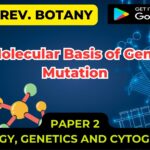Sex Determination
- A number of theories were postulated from time to time by the biologists to explain this critical phenomenon.
- Hippocrates and other theorists believed that the age or vigour of the parents was responsible for determining the sex of the offspring.
- The older or more vigorous parent tries to impress its sex upon the offspring.
- According to some philosophers if an egg is fertilized soon after ovulation it gives rise to female but if it remains in the oviduct for sometime before fertilization it produces male.
- Galen and various others claim that germ cells from the right ovary produce males while the germ cells from the left ovary produce females.
- Professor Shenk of Vienna put forward the Nutrition Theory.
- He assumed that high degree of nourishment to the mother brings about female offspring while less nutrition causes male offspring’s.
- These speculations of the early biologists are now replaced by more genetic and scientific theories.
Modern Theories of Sex Determination:
(1) Chromosomal theory or Theory of Heterogamy
(2) Genic balance theory
(3) Hormonal theory
(4) Theory of environmental factors.
(1) Chromosomal Theory or Theory of Heterogamy:
- The complete account of chromosomal sex determination was at first worked out by Stevens (1905).
- This view was later supported by other scientists such as Wilson, Bridge, Goldschmidt and Whitings.
- In majority of sexually reproducing animals two types of chromosomes are found:
(i) Autosomes:
- They are found in all cells.
- The genes present on autosomes are responsible for determining the somatic characters but sometime influence the sex of the organism.
- The two members of each homologous pair are similar in shape and size (homomorphic).
(ii) Sex Chromosomes or Allosomes:
- They carry genes for sex. A pair of them determines the sex.
- They are variously named as X and V chromosomes (Man and Drosophila), Z and W chromosomes (Birds and Moth), odd chromosomes, idiosoines, heterosomes or allosomes.
- The genes which determine the sex are being located on these chromosomes.
- The two members of this pair arc often dissimilar in male and are represented as X and Y chromosomes or as Z and W chromosomes.
(a) XX Female and XY Male Types:
- This type of sex mechanism is found in Drosophila (fruitfly) and majority of mammals including man.
- In this type the female is homogametic (XX) and male is heterogametic (XY) consisting of two dissimilar chromosomes X and Y.
- The females produce ova all of one type having X chromosome.
- Males produce two types of sperms: -50% with X-chromosome and remaining 50% with Y-chromosome.
- Thus, the sex chromosomes in female are homomorphic and those of male are heteromorphic (Fig.
(b) ZW Female and ZZ Male Type:
- In butterflies and birds, the female is heterogametic having dissimilar Z and W chromosomes whereas the male is homogametic having similar ZZ chromosomes (It is a convention to designate female as ZW instead of XY and male as ZZ instead of XX). The situation here is just reverse to first type.
(c) XX Female and XO Male Type:
- Mc Clung and Wilson (1903) described this type of sex mechanism in insects especially in grasshopper.
- In male there is no mate for X chromosome, hence the name XO is given, there is no Y chromosome.
- They produce sperm of two types, 50% with X chromosome and 50% without X.
- In females there are two similar or homomorphic sex chromosomes XX.
2. Genic Balance Theory:
- This theory was proposed by Calvin Bridges (1921).
- From his study on Drosophila he suggested that the X chromosomes carry factor for femaleness whereas autosomes “A” carry genes for maleness.
- Y chromosome does not take part in sex determination. it is clear that the genic balance is governed by the ratio of the number of X-chromosomes to the number of sets of autosomes in the zygote at fertilization.
- II the ratio is 1.0 the offspring develops into female, but if it is 0.5, then the offspring develops into male.
- If the ratio is intermediate between 1.0 and 0.5, the resulting individual is neither a male or nor a female but an inter sex.
- Super females have a ratio of 1.5 and super males have a ratio 0.33.
(3.) Hormonal Theory:
- Hormones are the secretion of the endocrine glands which in many instances modify the sex rather determining the sex.
- They are mainly responsible for the expression of secondary sexual characters.
- This theory is based upon the observation of Crew in chicks.
- In course of his investigation he found a hen which laid fertile eggs, accidentally lost its ovary, stopped laying eggs, and developed male characters such as comb and male plumage and became a cock.
- The above case of sex reversal is explained by assuming that destruction or removal of the ovary led to stoppage of production of the ovarian hormones.
- But the rudiment of testis (present in all female birds) became functional following the loss of ovary and produced male hormone which is responsible for the appearance of male secondary sexual characters.
- Such a male produced sperms and became father of two chickens.
- Another classical example of sex reversal by the action of hormone is observed in free martin.
- In cattle, when twin calves of opposite sex are born, the female is usually somewhat abnormal and sterile.
- Such a calf is called freemartin.
- Since the male hormone appears earlier in the development, it passes into the body of the under developed female through the circulation and causes partial sex reversal of the female.
(IV) Theory of Environmental Factors:
- Baltzer (1935) observed sex determination due to external environment in certain lower animals such as Bonellia.
- The adult female is several inches long but the male is very small of the size of large protozoa and lives in the reproductive tract of the female.
- The newly hatched young worm (Bonellia), when reared in isolation, develops into a female.
- But when, these are released into water containing mature females, some of them attach to the proboscis of female (to suck nourishment) develop into tiny males and come to lie in the oviduct of the female.
Sex Determination in Man:
- In case of man the total number of chromosomes is 23 pairs or 46. Of these, 44 chromosomes are autosomes (A) and the other 2 chromosomes are sex-chromosomes (XX in female and XY in male).
- In male, the diploid cells contain 44 A + XY chromosomes and the same in female contain 44A + XX.
- So the sperm will contain 22A + X (50%) or 22A + Y (50%) chromosomes and hence are of two types.
- On the contrary all the eggs are of one type and always contain 22A + X. When the sperm with 22A + X unites with an egg having 22A + X chromosome, the resultant zygote will be 44A + XX and it will develop into a female baby.
- But if a sperm with 22A + Y fertilizes an egg with 22A + X chromosome, the zygote will be 44A + XY and the baby will be male one .
- Thus, in man X-chromosome is female determining and Y-chromosome is male determining.
Role of Sex Chromosomes in Human Diseases:
- The presence of extra sex chromosome or absence of any sex chromosome causes certain diseases in man.
- It further supports the role of X and Y-chromosome in determining sex in human beings.
1. Klinefelter’s Syndrome (2n = 47 or 44+XXY):
- This disease is caused in man by the presence of an extra X-chromosome in male individuals.
- Such males possess 47 chromosomes (44 autosomes plus XXY sex chromosomes).
- They are sterile (incapable of carrying reproduction) males with under-developed genitalia, sparse body hair and some degree of breast development.
- They also exhibit mental retardation and limited intelligence. It arises due to non-disjunction (non-separation of XX during meiosis) of XX- chromosomes.
2. Turner’s Syndrome (2n = 45 or 44 + X):
- It is a disease caused in female individuals due to the absence of one X-chromosome.
- They have 45 chromosomes in stead of normal 46 chromosomes.
- Such females are sterile (unable to produce baby) with poorly developed ovaries and under developed breasts.
- They have webbed neck and broad chest.












